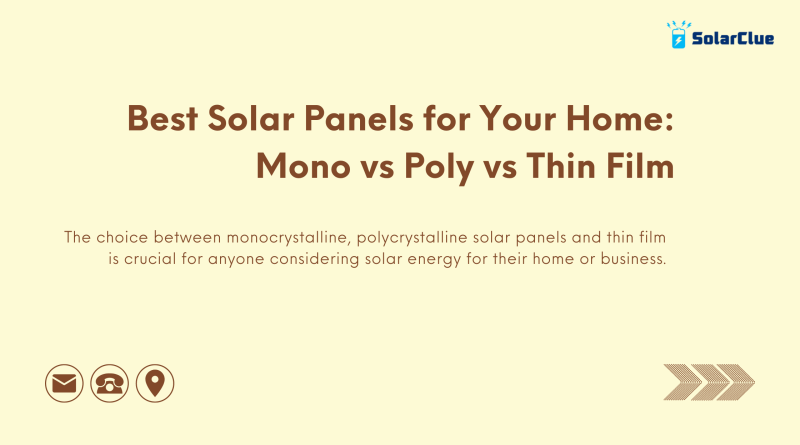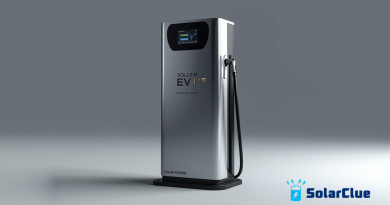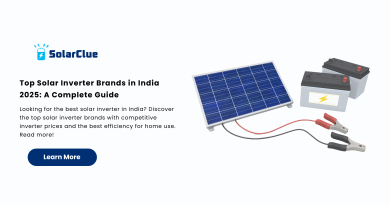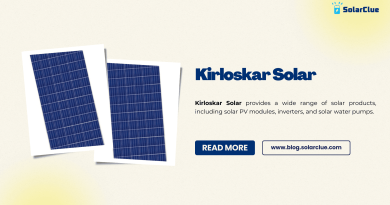Best Solar Panels for Your Home: Mono vs Poly vs Thin Film
Choosing the right solar panels for your home is essential for maximizing efficiency, cost savings, and aesthetics. In this blog guide, we will compare monocrystalline, polycrystalline, and thin film solar panels, focusing on their efficiency, cost, durability, and aesthetics. This will help you make an informed decision about which type of solar panel is best for home use.
Table of Contents
Understanding Solar Panels
The first and foremost step is to understand solar panels so that knowledge will help you to choose which type of solar panel is best for home use.
Monocrystalline Solar Panels
Monocrystalline solar panels are made from a single, pure crystal of silicon. They are known for their high efficiency and sleek, black appearance. These panels are often considered the premium choice for residential solar installations.
Polycrystalline Solar Panels
Polycrystalline solar panels are made from multiple silicon crystals melted together. They have a distinctive blue color and are typically less efficient than monocrystalline panels. However, they are more affordable and still provide reliable performance.
Thin Film Solar Panels
Thin film solar panels are made by depositing one or more layers of photovoltaic material onto a substrate. These panels are flexible and lightweight, making them suitable for a variety of applications. They are generally less efficient than crystalline silicon panels but offer unique advantages in specific use cases.
Efficiency of Solar Panels
Efficiency of Monocrystalline Panels
Monocrystalline panels are the most efficient type of solar panels, with efficiency rates typically ranging from 15% to 22%. This high efficiency is due to the pure silicon used in their construction, which allows electrons to flow more freely.
Efficiency of Polycrystalline Panels
Polycrystalline panels have efficiency rates between 13% and 17%. While they are less efficient than monocrystalline panels, advances in technology have narrowed the efficiency gap over the years.
Efficiency of Thin Film Panels
Thin film panels are the least efficient, with rates typically between 10% and 12%. However, they perform better in low-light conditions and at higher temperatures compared to crystalline silicon panels.
Cost of Solar Panels
Cost of Monocrystalline Panels
Monocrystalline panels are the most expensive due to their high efficiency and complex manufacturing process. Despite the higher upfront cost, their efficiency can lead to better long-term savings.
Cost of Polycrystalline Panels
Polycrystalline panels are more affordable, making them a popular choice for budget-conscious consumers. They offer a good balance between cost and performance.
Cost of Thin Film Panels
Thin film panels are generally the least expensive to produce. Their lower efficiency means they may require more space to achieve the same energy output as crystalline panels, but their low cost and versatility can be advantageous in certain applications.
Durability of Solar Panels
Durability of Monocrystalline Panels
Monocrystalline panels are known for their durability and longevity. They typically come with warranties of 25 years or more and can last even longer with proper maintenance.
Durability of Polycrystalline Panels
Polycrystalline panels also offer impressive durability, with similar warranties to monocrystalline panels. They are a robust and reliable option for residential installations.
Durability of Thin Film Panels
Thin film panels have a shorter lifespan compared to crystalline panels, usually around 10 to 20 years. However, their flexibility and lightweight nature can make them ideal for specific applications where traditional panels are not suitable.
Aesthetics
Aesthetics of Monocrystalline Panels
Monocrystalline panels have a sleek, black appearance that many homeowners find visually appealing. Their uniform look can blend well with various roof styles.
Aesthetics of Polycrystalline Panels
Polycrystalline panels have a distinctive blue color and a more varied appearance. While they may not be as aesthetically pleasing as monocrystalline panels, they are still a viable option for many installations.
Aesthetics of Thin Film Panels
Thin film panels offer a unique aesthetic due to their flexibility and variety of colors. They can be integrated into different surfaces, providing a more seamless and less intrusive look.
Comparing Key Features of Solar Panels
| Feature | Monocrystalline | Polycrystalline | Thin Film |
| Efficiency Rate | 15%-22% | 13%-17% | 10%-12% |
| Initial Cost | Higher | Moderate | Lower |
| Lifespan | 25+ years | 25+ years | 10-20 years |
| Appearance | Sleek Black | Distinctive Blue | Flexible, Varied |
Conclusion
Choosing the best solar panels for your home depends on your specific needs and circumstances. Monocrystalline panels offer the highest efficiency and sleek appearance but come at a higher cost. Polycrystalline panels provide a good balance of performance and affordability, while thin film panels offer flexibility and unique aesthetic options at a lower cost. Assess your priorities and budget to make the best decision for your solar energy investment. I hope you have took the decision on which type of solar panel is best for home use.
Here at SolarClue®, we offer a smart, practical, and “beautiful” solution. You will be answered for all the questions related to Solar.
We provide all kinds of brands that are the Best Solar panels in India.
If you are the one who is planning for the solar power system. Don’t hesitate to contact our team!
Looking forward to empowering you with solar energy, just like hundreds of our other clients!
Frequently Asked Questions
1. What is the main difference between monocrystalline, polycrystalline, and thin film solar panels?
Monocrystalline panels, crafted from a single silicon crystal, offer high efficiency and a sleek black appearance. Polycrystalline panels, made from multiple silicon crystals, provide lower efficiency and a distinctive blue color. Thin film panels, created by depositing photovoltaic material onto a substrate, offer flexibility and lower efficiency.
2. Are monocrystalline panels worth the higher cost?
If you have limited roof space or prefer a more aesthetically pleasing look, the higher efficiency of monocrystalline panels can be worth the investment.
3. How long do different types of solar panels last?
Monocrystalline and polycrystalline panels typically have a lifespan of 25+ years, while thin film panels last around 10 to 20 years.
4. Which type of solar panel is best for low-light conditions?
Thin film panels perform better in low-light conditions compared to crystalline silicon panels, making them suitable for certain environments.
5. Can I mix different types of solar panels in one system?
While it’s technically possible, it’s not recommended due to differences in efficiency and electrical characteristics, which can affect overall system performance.




